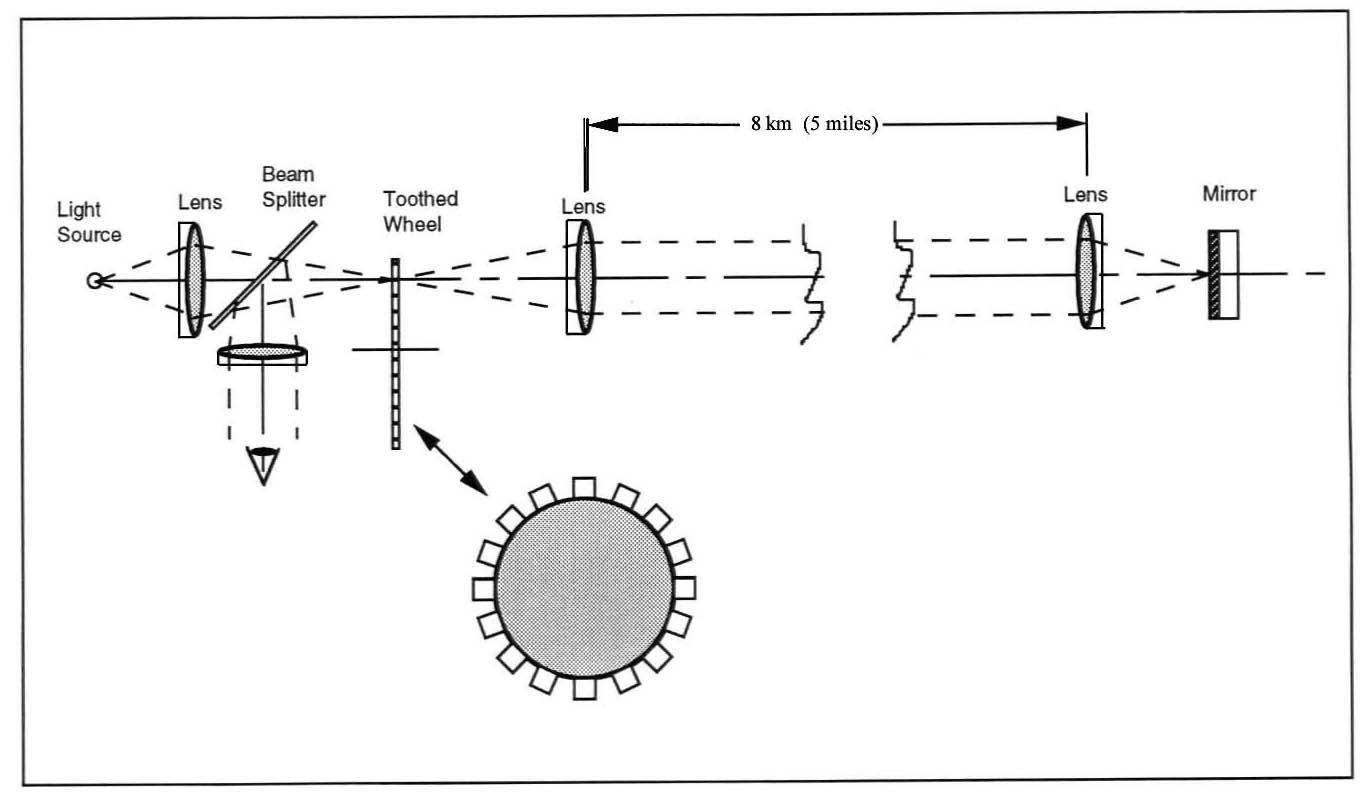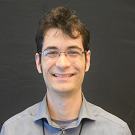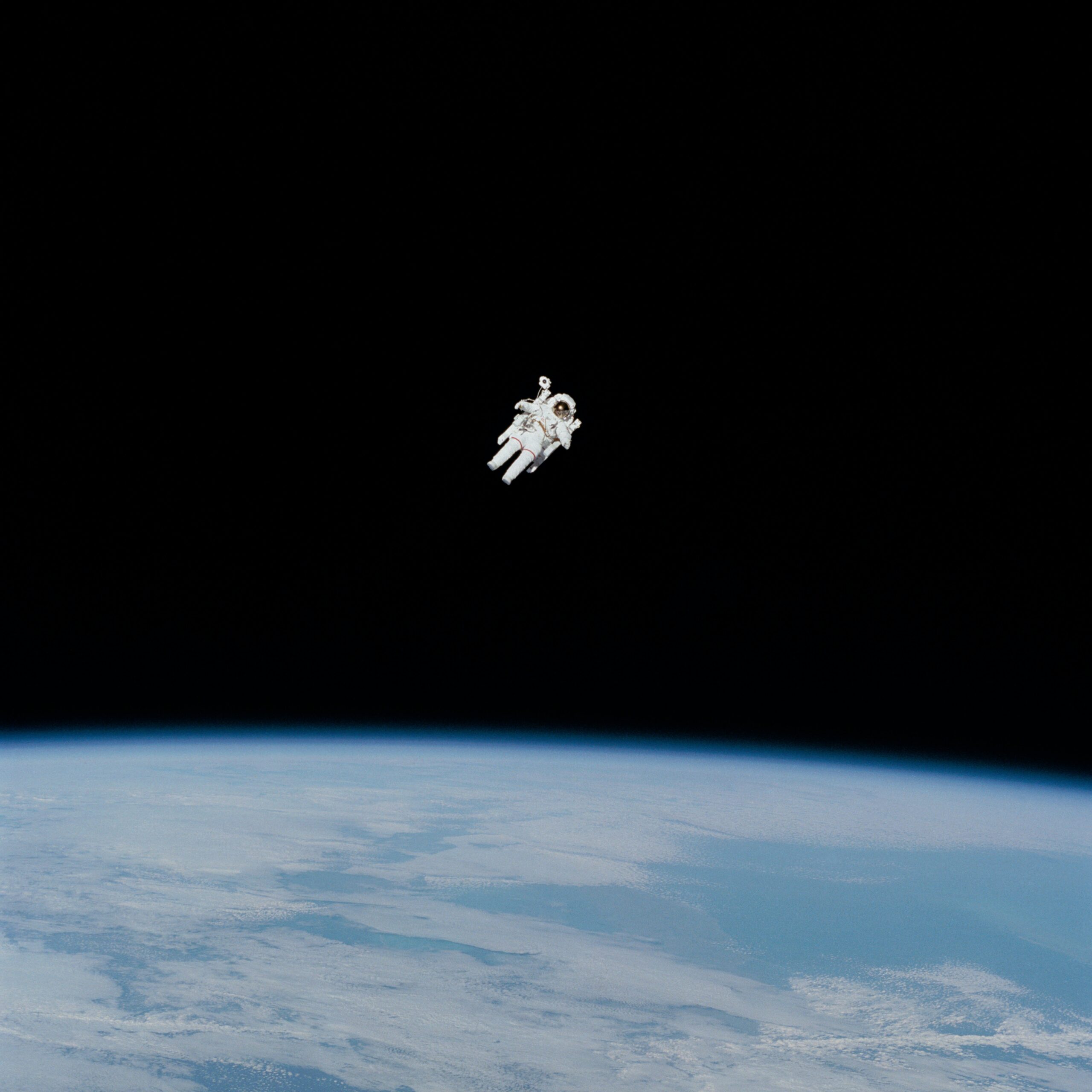For a lot of people, scientific discoveries can feel like wizardry, involving mind-boggling and high-tech apparatuses that only a chosen few know how to devise and operate. Over dinner one night, my mom confessed to being among those baffled by how scientists can figure out with any certainty aspects of nature so far beyond the human scale. How could we measure the size of infinitesimally small atoms or the distance to unfathomably remote galaxies? She sounded defeated asking these rhetorical questions, as if she was feeling left out for not knowing how to grapple with them.
In an effort to cheer her up, I thought I’d pick something to demystify: how we know the speed of light. Obviously light is very fast, so it might seem impossible to directly measure it here on Earth, but 170 years ago, French scientist Hippolyte Fizeau did exactly that. Here’s a diagram of the setup and a video of how it’s used:

I didn’t have the diagram or video on hand to show Mom, so I did my best to describe the experiment, emphasizing how the different components worked together—that a light shined down a five mile long tunnel at a rapidly spinning toothed wheel to produce a shadow in an eyepiece.
I hoped my description would’ve made her more comfortable with the idea that good old-fashioned ingenuity could reveal a lot about something as ineffable as light. But she just shook her head. “Toothed wheel? Five mile long tunnel? It’s still beyond me.” I didn’t have anything to add so I just shrugged and kept eating. It didn’t seem like I helped her view science to be any less esoteric.
A few days later, I was mulling over what she said when it occurred to me that her response pointed to an image problem of the scientific field. For those intimidated by the scientific process, they might just be fixated on the complicated or grand stuff scientists are using. Weirdly shaped glassware, laboratories resembling Willy Wonka’s Chocolate Factory, and in the case of Fizeau’s experiment, a gigantic tunnel and a funny-looking wheel. All these props can make the scientific community look like a clique operating on some higher plane out of the reach from the Everyman.
It was while I was struggling to think of how to describe the scientific process in a more relatable way that I realized in picking my example I hadn’t gone far enough back in the past. I had to go to a time before excavators and electrification, before microscopes and telescopes and scopes of any kind.
Even without elaborate equipment, people could still ask a question like, “What is the nature of light?” It’d be easy to answer we’ll never know. Those who instead said I’ll figure out a way to know—those were the first scientists, or as they were known back then, natural philosophers. But with hardly any technology, what can you learn about light?
Whatever you can, however you can, with patient observation and a commitment to always dig deeper.
Long ago, people noticed that light from the sun shines through a crack in a wall and comes through as rays. This was one of the first things we learned about light. The ordinary nature of this observation belied its significance. Digging deeper revealed a fundamental truth: light travels in straight lines. More importantly though, it raised the question: if we can understand this about light, what else could we figure out with basic tools?
Got a mirror? 2,200 years ago, that was enough for Euclid of Greece to formulate a law of reflection. How about a piece of glass and some water? Alhazen of Persia used those 1,000 years ago to determine the relationship between the density of a material and the angle that a ray of light changes direction, or refracts, when going through it. For the intrepid natural philosopher, even the speed of light was a ripe subject for a low-tech experiment. In the 17th century, Galileo of Italy attempted to calculate it by trying to detect a time delay in seeing the flame of a lantern appear atop increasingly distant hills. It didn’t work; he didn’t sense any delay, but the failure was instructive—it suggested that light had to be moving extremely fast.
None of this means that technology isn’t helpful. Euclid and Alhazen would’ve loved to have used the perfectly straight beams of a laser pointer to more efficiently arrive at their conclusions. Galileo could have had an easier time sensing a time delay if he had a stopwatch that could measure thousandths of a second and a powerful telescope to see the flame from further away. But they weren’t about to while away their time waiting for ideal tools to materialize. They had to do the best they could with what they had. This often meant they were limited to contributing only an incomplete or imprecise understanding of light. However, this imperfect understanding could be passed on to a successor to improve.
Which brings us back to Fizeau—this time with the proper context. He didn’t come up with his experiment in a vacuum. Thanks to the insights of many dedicated predecessors, he had a clear idea of the conditions necessary to produce his calculation, and he recognized the technology available to help make it happen.
Fizeau didn’t have the last word, either. It turned out there were flaws in the design of his experiment that introduced some error in his calculation. For decades after Fizeau’s original experiment, work would continue to refine the value for the speed of light (current measurements put it at 186,282 miles per second).
Today, our menu of scientific instruments has ballooned. We now have particle accelerators, mass spectrometers, electron microscopes; things we should see for what they are—the latest versions of tools with humble origins, helping answer timeless questions about nature for those who say we’ll figure out a way to know.
Make some discoveries of your own about light with these simple experiments you can try at home:
- Create rays. Take an index card and cut a narrow slit in it. Shine a flashlight through the slit and observe rays come out from the other side. What happens to the rays as they shine farther and farther distances?
- Investigate the law of reflection. Place a cardboard box on a table and tape a mirror to one side of the box so the mirror is flush with the table. Put a piece of paper under the mirror. Shine rays at the mirror the same way you did in activity 1. Try small angles and large angles and trace the paths on the paper that the rays make before and after they hit the mirror. What pattern do you see?
- Investigate refraction. Fill half a cup with water. Put a straw in the water. How does the straw look when looking down through the water? Rays refracting (changing direction) in the water can cause objects to look “bent”!

Nick Villagra is a STEM Educator at the Connecticut Science Center, responsible for developing and delivering science experiences, including classroom lab programs, stage shows, and vacation camps. Nick holds a Bachelor’s of Science in Engineering from Swarthmore College. and has been a speaker at the New England Museum Association conference. Always looking to put a unique stamp on the Science Center’s offerings, Nick enjoys incorporating custom-designed 3D printed materials for students to interact with.



